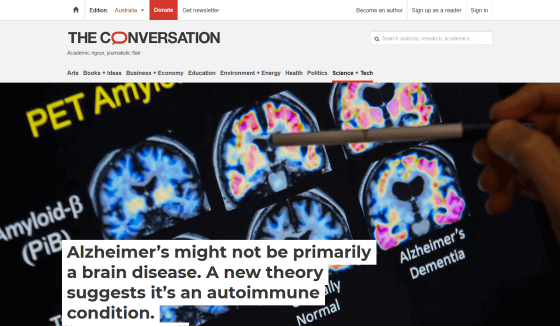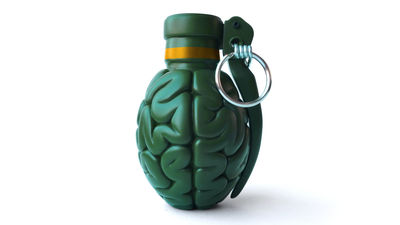Scientists propose a theory that ``Alzheimer's disease is an autoimmune disease in which the immune system mistakes brain cells as bacteria and attacks them.''

Alzheimer's disease is a disease that accounts for 60 to 70% of dementia cases, and although scientists around the world are researching treatments, at the time of writing,
Alzheimer's might not be primarily a brain disease. A new theory suggests it's an autoimmune condition.
https://theconversation.com/alzheimers-might-not-be-primarily-a-brain-disease-a-new-theory-suggests-its-an-autoimmune-condition-189047

It is known that a type of protein called amyloid-β accumulates in the brains of Alzheimer's disease patients, and many researchers are researching treatments on the assumption that amyloid-β is the cause of Alzheimer's disease. . In 2021, ADUHELM , an Alzheimer's disease drug that reduces amyloid beta, was approved by the US Food and Drug Administration, but some are questioning the effectiveness of ADUHELM.
Dr. Weaver said, ``Why are researchers struggling to find a cure for Alzheimer's disease, one of the most important diseases facing humanity, when so many people need effective treatments?'' 'Isn't that so?', he said, and suggested that since the development of treatments focusing on amyloid beta has not yielded effective results, it may be necessary to consider the problem from a different approach.
The new theory proposed by Mr. Weaver's laboratory is that ``Alzheimer's disease is not a disease of the brain itself, but an autoimmune disease caused by the immune system in the brain.''

The immune system is present in every organ in the body, and is a system of cells and molecules that work together to heal injuries and fight off pathogens. For example, when a person falls and is injured, the damaged tissue is repaired, and when a person is infected with a virus or bacteria, these pathogens are killed and eliminated. Similar processes exist in the brain to deal with damage and pathogens.
Weaver believes that amyloid-β, which is thought to be the cause of Alzheimer's disease, is not an abnormal protein, but a normal protein that plays a part in the brain's immune system. When the brain is damaged or invaded by pathogens such as bacteria, amyloid-β contributes to the brain's comprehensive immune response.
The problem here is that bacteria and the fatty molecules that make up the membranes surrounding brain cells are very similar. Weaver believes that amyloid-β cannot distinguish between bacteria, which have similar fat molecules, and normal brain cells, and may mistakenly attack the brain cells it is supposed to protect. Weaver argues that this causes a chronic and progressive loss of brain cells, eventually leading to the development of dementia.
If you consider that Alzheimer's disease is the result of the brain's immune system mistakenly attacking normal organs, then Alzheimer's disease can be considered a type of autoimmune disease. So far, steroid treatments that are effective for other autoimmune diseases such as rheumatoid arthritis have no effect on Alzheimer's disease, but the development of drugs that target immunoregulatory pathways in the brain could effectively treat Alzheimer's disease. There is a possibility that it can be done.

Weaver pointed out that Alzheimer's disease, which affects more than 50 million people worldwide, is a major public health crisis. He argues that it is necessary to better understand Alzheimer's disease and create treatments for the well-being of dementia patients and their families, as well as to reduce the socio-economic costs of dealing with the ever-increasing number of dementia patients. Did.
Related Posts:
in Science, Posted by log1h_ik







